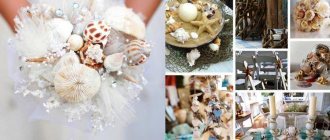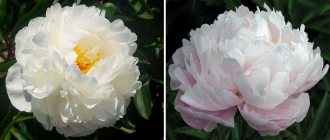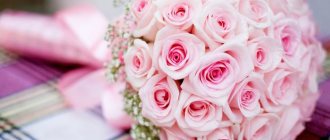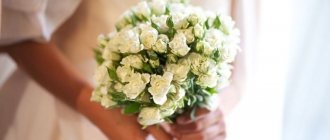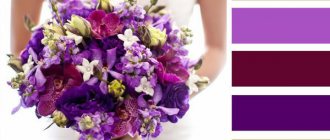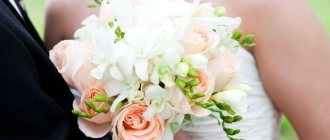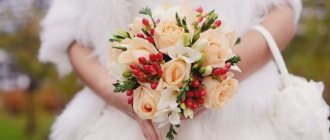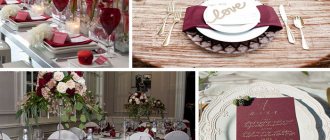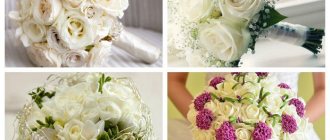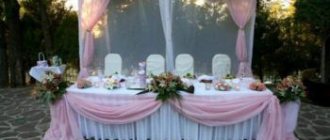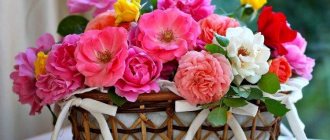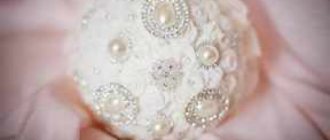When buying a wedding bouquet, you can be overwhelmed by the wealth of choice. A classic option that never goes out of style and remains the most popular and in demand is a wedding bouquet of fresh roses. We’ll look further at how to choose the right floral arrangements of roses and with which bride’s outfit will look great.
Features and Benefits
Content
Roses are mainly bred for decorative purposes; this flower is loved by florists all over the world. And this is not surprising, because the plant has a number of advantages. Its long and strong stem allows you to create flower arrangements of any shape; it is quite elastic and acts as a frame for other flowers.
The variety of varieties is also surprising; you can make a bride’s wedding bouquet from roses of any shape and size, thereby adding volume to the composition. Rose petals of different shades are a favorite decorative material for decorators.
And of course, one cannot fail to note the subtle and pleasant aroma, which has been the basis of most perfume compositions for many centuries. Breeders are developing new varieties with a strong odor; extracts are prepared from these plants for the cosmetic and pharmaceutical industries. The scent of roses is subtle and unobtrusive, which is another plus in favor of this plant when choosing a bridal bouquet.
Forms
It is known that bouquets can be of different shapes, let's look at the most popular ones that are made from roses:
- Classic hemisphere , it can be very miniature or larger and more magnificent, in which the flowers are pressed tightly against each other.
- Cascade , looks like it is made of several tiers.
Most often, lilies, orchids or calla lilies are used to make such compositions together with roses. - In the form of a muff , this is one of the latest fashion trends; it is made of natural or artificial fur, and flower buds adorn the top. Such an accessory, of course, is relevant in the cold season; it will help warm the newlywed’s hands, fit into the winter look of the newlyweds, and surprise guests with its originality.
Varieties of colors
In addition to the usual pink, yellow, red and white flowers, breeders offered roses in cream shades, as well as flowers with gradient colors. Of course, roses of unusual shades have always attracted special attention, for example:
- Green.
- Black.
- Purple.
- Blue.
Recommendations
The good thing about a natural bouquet is that you can make it yourself, saving significantly on the services of professional florists.
Some wedding styles, such as country or rustic, encourage the use of homegrown plants. Daffodils, tulips, peonies, gerberas, and roses bloom beautifully in the gardens of the middle zone. Thus, the bouquet will turn out to be both budget-friendly and sincere.
If you want to use imported flowers, be sure to consult with a florist you know to purchase a quality product. Place your order in advance, at least a month before the wedding. This way you will definitely get exactly the plants you dreamed of.
Take into account some negative nuances of a bouquet of fresh flowers:
- Fragility - not all petals will withstand numerous touches, frost, direct sunlight and drought, so carefully read the characteristics of the selected plants and, if necessary, place them in a vase immediately after the ceremonial procession and photographs.
- For a winter celebration, it is wise to choose from frost-resistant flowers, since there are quite a lot of them - carnations, tulips, ranunculus, chrysanthemums, and some types of roses.
- An important point is the smell and pollen. Some buds, for example, lilies, have a powerful aroma that will overpower your perfume and cause headaches or allergies. The same lilies are “famous” for their stamens, which can leave an orange mark on a dress.
Decide what exactly you want from the composition - shape, shades, specific plants. Be sure to take into account both your own external data and the theme of the wedding. Classic celebrations love strict lines, thematic celebrations love asymmetry, cascade, and unusual execution. Tall brides should choose a larger bouquet, short brides should choose a miniature and neat one.
If you are determined to make an important accessory yourself, then soberly assess your capabilities.
Without any experience, you should not try to immediately repeat complex floral masterpieces, especially with expensive flowers. Start simple - with a classic circle. To create this shape, flowers are placed slightly at an angle, so that the buds create a circle and the stems create a single stem.
It is best to choose plants with straight but rather flexible stems for such compositions. However, in any case, you will have to secure the leg with floral wire. If desired, the leg can be replaced with a porta bouquet. On top we add decor carefully selected for the floral composition, outfit and style of the wedding - satin ribbon, a piece of chiffon fabric, lace.
A more complex option is a cascading composition in the form of a waterfall. For it you will need a little more time, an abundance of greenery and plants with the longest stem possible, or with a natural flowing shape, for example, orchids.
An interesting and simple to make pomander is a bouquet in the shape of a sphere, attached not to a stem, but to a ribbon. For it you will need a round floral sponge, into which you will place the buds.
Combinations with other plants
Florists advise combining the following plants with roses:
- Small flowers: gypsophila, spray chrysanthemums of various varieties, astrantia. They will well emphasize the sophistication of pink buds.
- Exotic orchids, freesias, callas and lilies will look great in a bouquet with small roses.
- Peonies. They are perfect for a bouquet of double roses; these flowers are very similar, so the composition will look uniform and harmonious.
- Lilac. An unexpected but very beautiful combination. The bouquet turns out to be delicate and refined.
In any composition, flowers should be combined not only in appearance, but also in color. For wedding bouquets, the use of snow-white or cream flowers, with a difference of one or two tones, is considered a classic. Two-color contrasting combinations look interesting, for example, blue and white flowers, but using more than two bright shades in a bouquet is only possible if the theme of the event requires it.
What is Alstroemeria?
It is unlikely that anyone will have questions about what a rose looks and smells like, but many are probably not familiar with the name “alstroemeria”. However, those who have seen an orchid and a lily, of which this lovely flower is a hybrid, can easily imagine it.
The homeland of this plant is South America. Alstroemeria is also called the Lily of the Incas, or the Peruvian lily.
The species diversity of this flower is great, but most varieties and species are not adapted to our climatic conditions, so not all options may be available (of course, if the celebration is not planned somewhere in the Falkland Islands).
Among the advantages of alstroemeria are:
- durability , because this plant can remain fresh when cut for up to one month;
- lack of odor , which allows you to combine it with any colors;
- the large length of the stem allows you to create a bouquet of any length and shape;
- Glossy alstroemeria leaves will perfectly complement the bouquet.
As for the color scheme, brides have quite a wide choice. Alstroemerias come in white, pink, and orange; thanks to selection, other shades are also found. You can choose single-color or two-color buds.
How to choose a bridal bouquet of roses
When choosing flowers, it is important to maintain a balance between practicality and beauty. Simple rules will help you make the right choice:
- The bouquet should not contain protruding thin or sharp branches, as they can tear the dress.
- In hot and sunny weather, you should not take a bouquet with delicate flowers; they will spoil and will not complement the bride’s image well. A good option is a wedding bouquet of small spray roses, to which chrysanthemums, eustoma, and decorative greenery are added.
- It is better to wrap the stems with ribbon or paper so as not to stain the gloves and the bride’s outfit.
- The shape of the bouquet should fit organically into the overall image. Fragile and small girls should not choose cascading, bulky compositions, while tall and stately girls should pay attention to them. A round classic bouquet will suit everyone without exception.
Another option to avoid making a mistake with your choice is to make the bride’s bouquet with your own hands. It's not as difficult as it might seem. But the result will certainly meet all the requirements and wishes, and you will definitely be confident in the freshness and quality of the flowers.
Decor elements
When the wedding bouquet is assembled, the stems are tightly tied with tape, but the design does not end there. To make the composition elegant, the handle is decorated with a satin ribbon or lace braid. You can secure the tape with pins, inserting them tightly into the stems.
Additional decoration elements can be beads, bows, brooches. They are carefully glued, making sure that the glue does not bleed through. The color of the decorative elements should match the color of the roses. Don't go for a bouquet that is too big and lush. Remember that the bride will have to hold it in her hands for a long time, and she may get tired.
Comments (0)
Combination with the bride's outfit
The main rule that will help you choose a bouquet is that the flowers should be two shades darker than the dress. Snow-white roses can be taken in two cases: the outfit is the same white, or in a different color scheme. If there are bright accents in the image, then the bouquet should contain flowers of the same shade. And, of course, it is important to take into account the bride’s style and select options that correspond to the overall theme of the event.
Complex and multi-tiered compositions are appropriate if the outfit is elegantly cut, without a fluffy skirt with rings.
It is good to complement the outfits of the bride and groom with accessories from the flowers that are in the bouquet: a boutonniere, a hair clip, bracelets.
Selection rules
Charming plants are quite capricious. They are difficult to give the required shape, so if you do not have much experience in composing such compositions, it is better to contact a professional florist. This is especially true for complex non-standard bouquet shapes and the use of an abundance of shades.
Here are some more useful tips:
- Shrub roses have a rather spicy scent , so be sure to check in advance to see if you are allergic to it. If necessary, ask to treat the buds with a special solution that will muffle the aroma;
- Young girls look great with buds just beginning to bloom , older women - with fully formed inflorescences;
- Take care of the convenience of the bouquet handle. It should not be too wide, short, slippery, scratchy, or with protruding thorns. Remember that you will have to carry the accessory in your hands all day, so it will be useful to think about your own comfort;
Important! Roses are available year-round, but still contact the salon in advance, at least a couple of weeks before the wedding, because the desired shade or variety may not be available.
- Flowers should be as fresh as possible and treated with a special composition that slows down fading. The wedding day is quite long, and the buds cannot do without help;
- Choose a bouquet when you have already completely decided on the dress, makeup, hairstyle and theme of the celebration , because even the most beautiful accessory loses its charm in an inappropriate setting.
